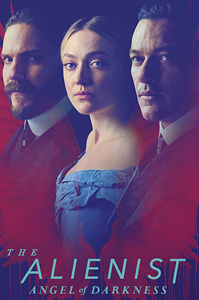With all the depressing news in the world lately, it’d be nice to get a happy new TV show to watch. So on Sunday, TNT launched the new season of – cue record scratch – “The Alienist.” While this is perhaps not the type of series we need right now, there’s no denying that in its second season — subtitled “Angel of Darkness” and running in two-hour blocks over four Sundays — it remains one of the best-looking shows on TV.
And despite being set in 1897, it’s timely. In Sunday’s episodes, writer Stuart Carolan and director David Caffrey (working from Caleb Carr’s 1997 novel) demonstrate that the more things change, the more they stay the same.
New York City officials execute a woman (Georgia Lowe as Milly) wrongly convicted of killing her baby. A gallery of officials watch as Ted Levine’s mustachioed Police Chief Byrnes excitedly unveils the new, “humane” method of killing: the electric chair.

“The Alienist” Season 2: “Angel of Darkness” (2020)
TNT, 8 episodes
Showrunners: Eric Roth, Hossein Amini, Cary Joji Fukunaga
Stars: Daniel Bruhl, Dakota Fanning, Luke Evans
Outside, advocates for women’s suffrage shift their protest to the state’s murder of a woman, and many of them are beaten away by cops’ batons. In addition to the basic fact that there shouldn’t have been enough evidence to convict her, Milly’s supporters contend that non-mothers can’t understand that a mother might act hysterical after losing a baby without necessarily being the killer.
Repeated history, even in the details
History is doomed to repeat itself, and this shows even in the details. It’s always wrong for the state to kill citizens, but this episode focuses on a specific bias that might lead to mothers being assumed to be baby-killers. It parallels the search for the reasons why today’s blacks are killed by police in a higher percentage than other races.
“Angel of Darkness” features the same three leads as in Season 1, but it switches the main character from alienist Dr. Laszlo Kreizler (Daniel Bruhl) to his former assistant Sara Howard (Dakota Fanning), who has opened up her own detective agency.
She’s arguably perfect for investigating the string of baby kidnappings/murders because she’s a woman (and indeed she makes that argument to prospective clients), and her two assistants are women. But even the next mother whose baby is snatched, Senora Linares (Bruna Cusi), hesitates to hire a woman.
Adding more timeliness: Linares is the wife of Spain’s ambassador, and because Spain and the USA might soon go to war regarding Cuba, there is racial tension against Spaniards. So she’s hesitant to call the police, knowing she’ll get poor service at best, and be arrested and executed at worst.
I’m a little disappointed to find that Sara and John Moore (Luke Evans) – a former freelance illustrator now writing and reporting for the New York Times – have stalled in their courtship process. I know it’ll pick up again as the season goes on, but it’s jarring to see that John is engaged to Violet Hayward (Emily Barber), considering that his awkwardness around women is a central trait in Season 1.
Again, a muddled mystery
The mystery again is decent, but not the show’s strongest suit. It’s chilling that babies are targeted – we are somewhat braced for this, since kids are the Season 1 victims – but the “means, motive, opportunity” aspect of the mystery is muddled.
We know Byrnes and his corrupt police are covering things up, and we know a certain hospital has power over babies’ and mothers’ fates, but what game are they playing?
The mystery is a red herring as to why “The Alienist” is so good, though. The trump card is the way it brings 1890s New York City to life. I marvel at the lawlessness and squalor of certain parts of the city, and almost want to put a handkerchief to my face when Moore does. There’s also a romance about the heady early days of powerful newspapers, as we see the New York Times being delivered and peddled from horse carriages.
At the same time, we see behind the scenes how the Times and the New York Journal “make” the news, as both papers’ editors decide that Milly is guilty because that’s what their readers want. Worries about “fake news” very much predate the internet age. But at least there’s competition, and I’ll be as interested in John’s fight for the truth via his Journal typewriter as in his romantic pursuit of Sara.
I don’t expect to be uplifted by “Angel of Darkness,” but I expect I’ll have an excellent grasp of the 1897 Big Apple by the end of these eight hours.


